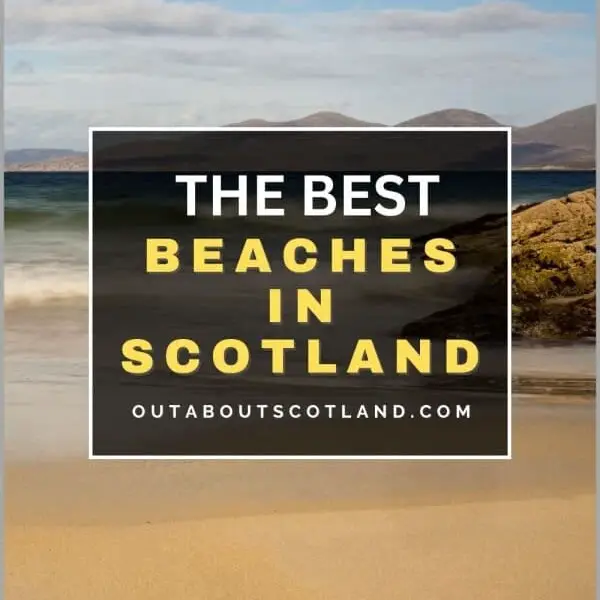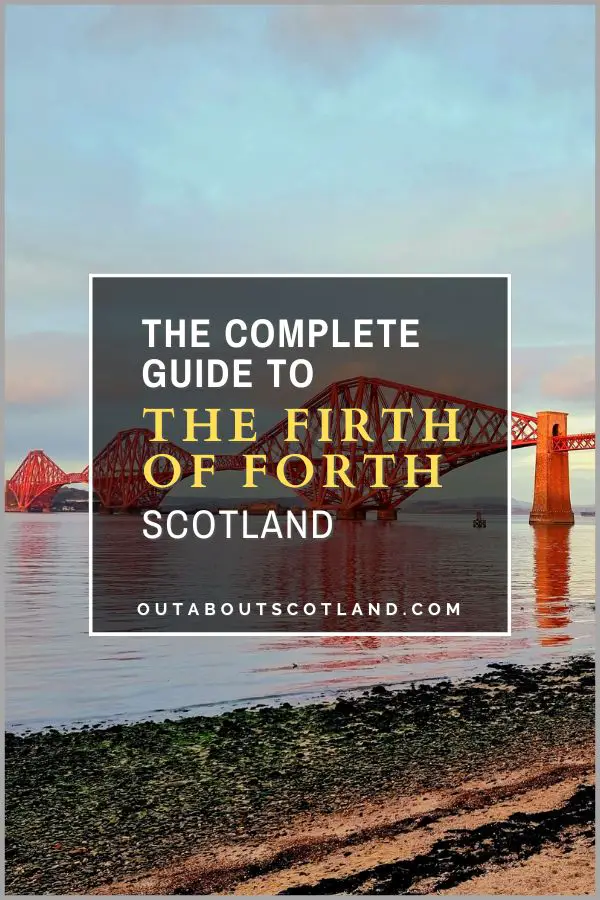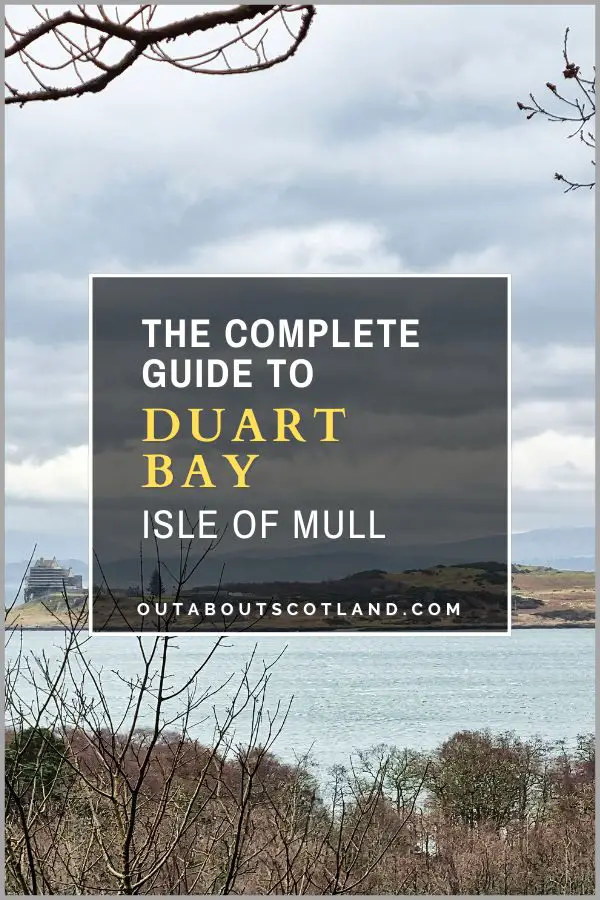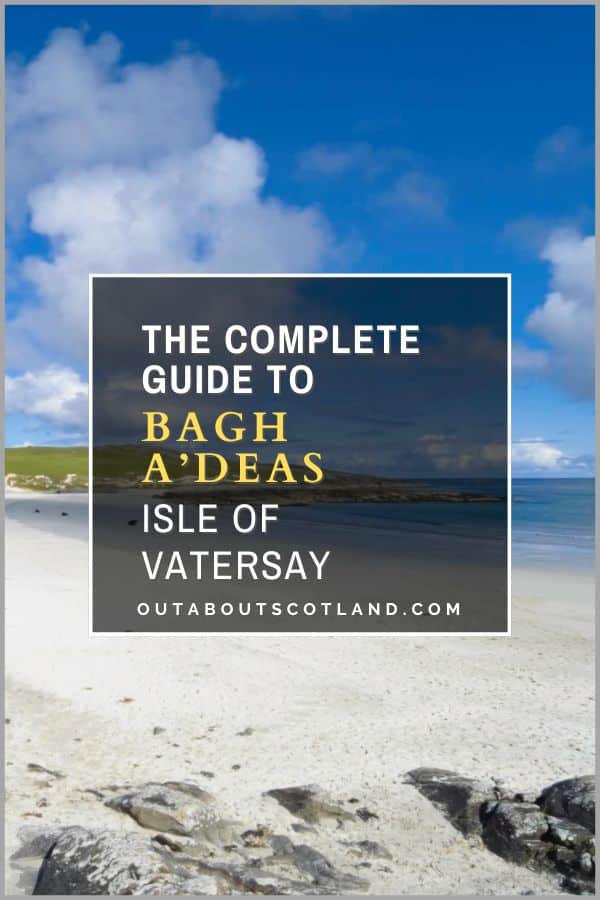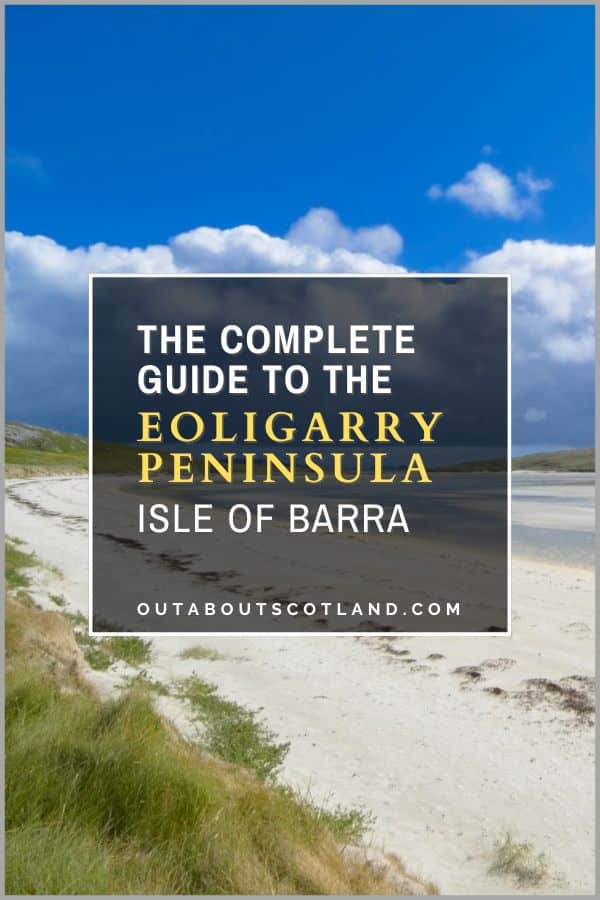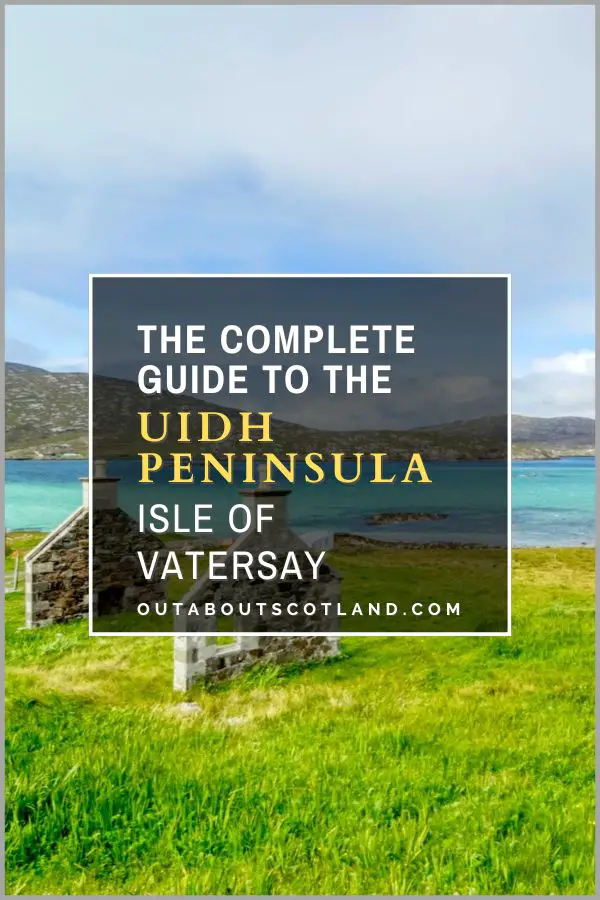In this article, we’ll dive into Scotland’s top must-visit coastlines, from the ice cream parlours and shoreside cafes of Aberdeen to the pristine white sand on the rugged islands of the Outer Hebrides. Scotland has an incredible array of sandy shores and secret coves that are just waiting for tourists to discover along its 11,600 miles of breathtaking coastline.
Whether you have an interest in famous beaches like Luskentyre on Harris or less-known places like Traigh Mhor on Barra, Scotland offers the perfect escape for sunbathing on powder-soft sand and swimming in turquoise waters.
1: Luskentyre – Isle of Harris
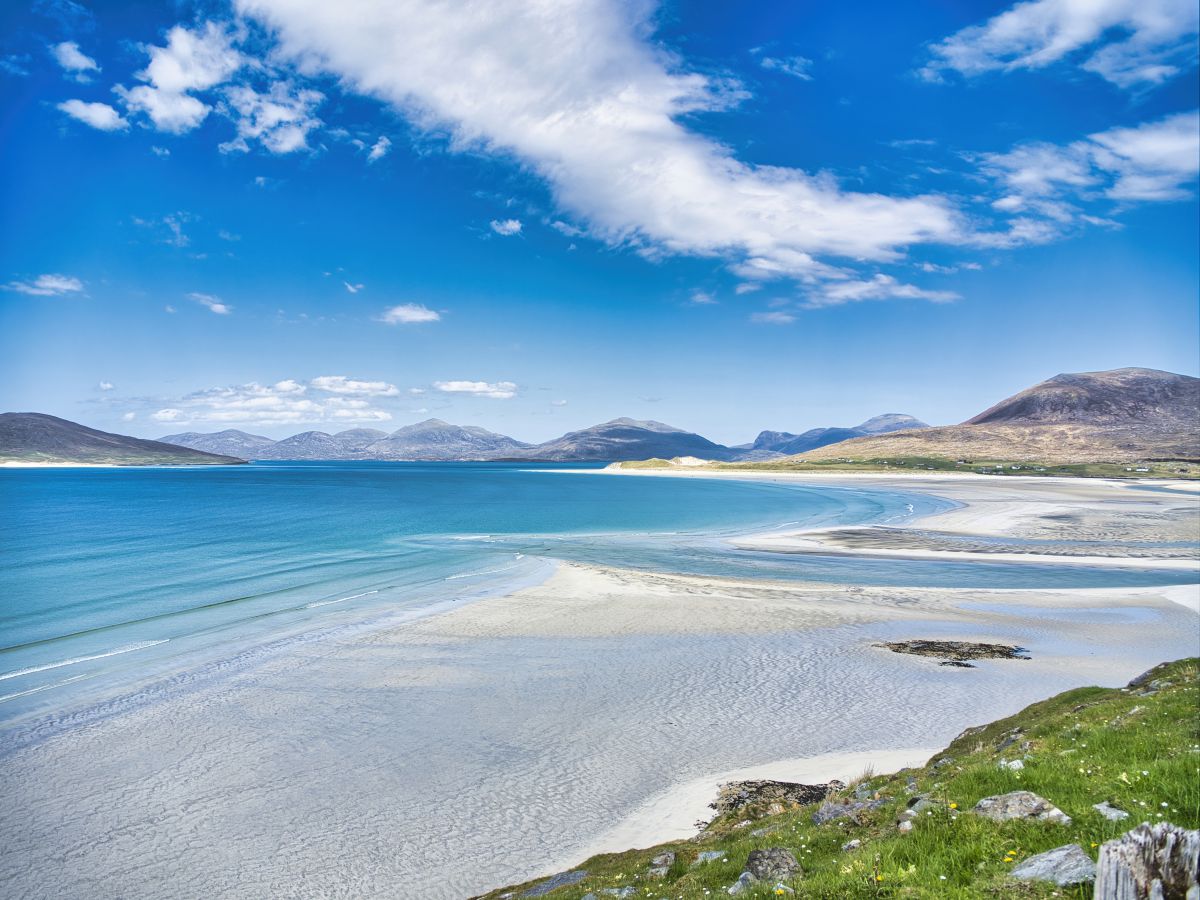
| Address: | Isle of Harris, HS3 3HL |
| Opening Hours: | 24/7 |
| Admission Price: | Free |
| Parking: | Free. Dedicated car park and off-road parking spaces |
| Contact: | N/A |
| Facilities: | Toilets in car park |
| Photos: | Virtual Tour |
Out About Scotland Guide: Luskentyre Beach
Luskentyre, situated on the west coast of the Isle of Harris in the Outer Hebrides, is one of (if not the) most beautiful beaches in Scotland. It’s famous for its white sandy shores, deep blue waters, and breathtaking views which take in the mountain ranges of North Harris and the island of Taransay – home of the BBC’s Castaway TV show in 2000.
The sand of Luskentyre Beach is well over a mile long and offers plenty of space for visitors to explore, relax, and take in the natural beauty of the landscape which has been labelled one of the world’s most beautiful places on a number of websites including TripAdvisor and Conde Nast.
The area surrounding Luskentyre Beach is rich in wildlife and visitors will be treated to sightings of many different bird species, seals, and sometimes even dolphins and whales. If you don’t have a pair yet, you might like to pick up a cheap pair of binoculars (link to my binocular reviews) to throw in your bag for your visit.
The beach can be accessed by a single-track road from the A859 on Harris which is signed with the Gaelic name ‘Losgaintir’. There are several places to park along this road that closely follows the shoreline so you can take in the scenery, but be aware that it gets very busy in the summer and that campervans will occupy the majority of the spaces.
Thankfully, there’s a tarmacked car park at the end of the road that has toilets and many more parking spaces. Access to the beach is over dunes on a rough path which opens up to gobsmacking views of Traigh Rosamol where you can then walk in a circular route back to the Losgaintir road or head across sandflats to the equally scenic Seilebost beach.
When visiting Luskentyre Beach it’s a good idea to take warm clothing as the weather can be unpredictable even in the summer months, and as there are no shops or snack vans in the area it’s advisable to stock up on supplies in Tarbert (postcode HS3 3DN) before setting out.
2: North Tolsta – Isle of Lewis
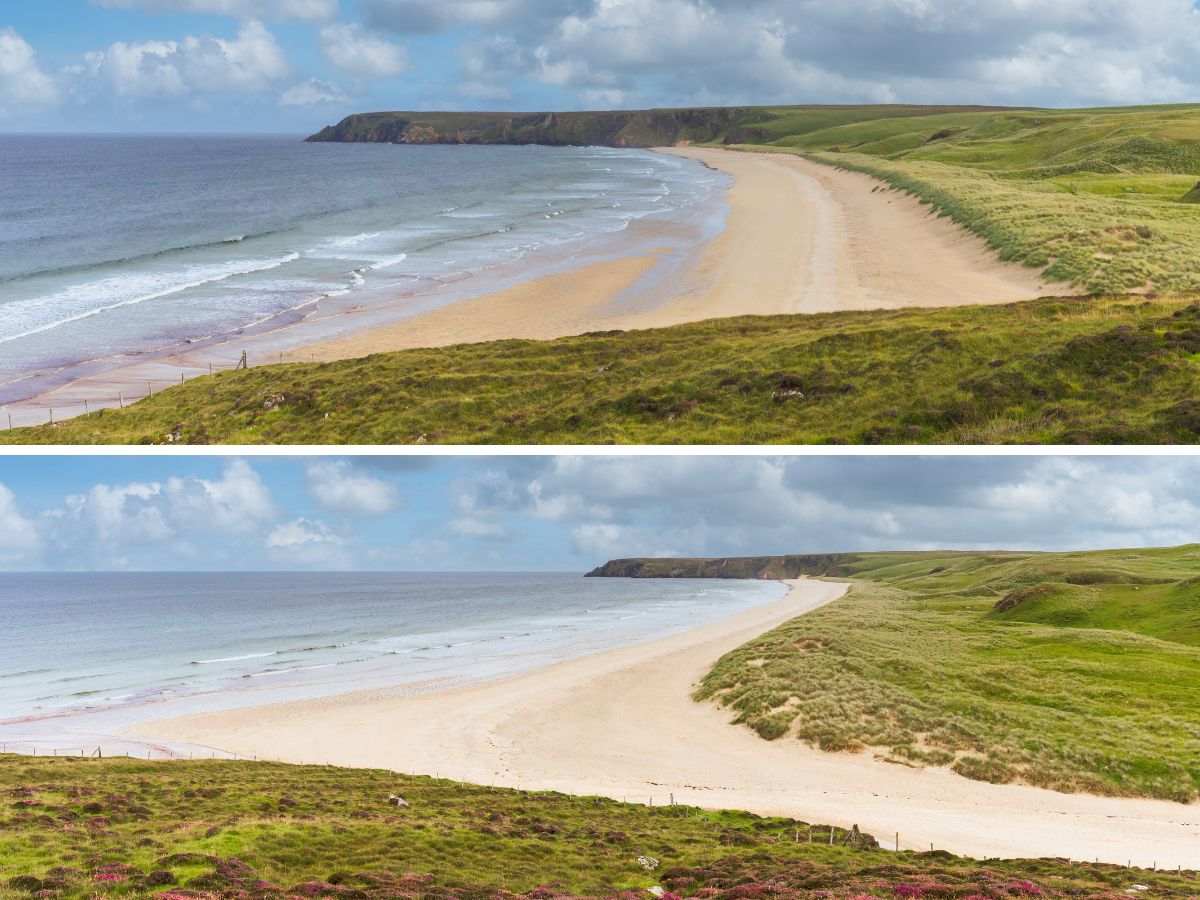
| Address: | Stornoway Ferry Terminal: HS1 2AE Lews Castle: HS2 0XS Callanish Standing Stones: HS2 9DY Gearrannan Blackhouse Village: HS2 9AL Butt of Lewis: HS2 0XH |
| Opening Hours: | The Isle of Lewis is open 24/7 365 days a year. Arrivals are dependent on Calmac sailings. Attraction times are dependent on the operator. |
| Admission Price: | Attraction entry prices are dependent on the operator. |
| Parking: | Melbost Beach Car Park: Bhraighe Road, HS2 0PA Stornoway South Beach Car Park: Stornoway, HS1 2BE Gress Car Park: HS2 0NB Eoropie Beach: HS2 0XH Dun Carloway Car Park: HS2 9AZ |
| Contact: | N/A |
| Facilities: | Stornoway: Public toilets, cafes and restaurants, supermarkets, petrol stations, shops, medical facilities, police station, gift shops, car parking, tourist information, boat tours, ferry terminal, airport, hotels and B&Bs. Attraction facilities are dependent on the operator. |
| Photos: | Virtual Tour |
Out About Scotland Guide: Isle of Lewis
North Tolsta Beach, also known as Traigh Mhòr, is the largest beach on the Isle of Lewis, stretching 1.4 miles across the Minch, the 30+ mile channel between Lewis and the mainland. Like most other beaches in the Outer Hebrides, it’s known for its stunning white sands and crystal-clear turquoise waters, which are reminiscent of a far-flung tropical paradise—at least in the height of summer when the temperature averages 18°C (which is quite warm for Scotland!).
While the water can be quite cold it’s still good for a refreshing swim as the bay is nice and shallow, but if you’d rather stay on the beach there are a couple of spots on either end where it’s possible to tuck yourself away in the dunes to sunbathe.
North Tolsta Beach’s dynamic landscape, which is a result of the shifting tides and sands, attracts photographers, but birdwatchers also flock to the beach in large numbers to see coastal and migrating birds.
This part of Lewis offers plenty of opportunities for hiking and exploring the rugged coastline thanks to numerous trails that lead to other points of interest like the ultra-secluded Garry Beach (accessed via a narrow track on the northern end of Traigh Mhor), and the Tolsta Heritage Trail which follows the coastline from the Bridge to Nowhere for 10 miles to the Port of Ness near the Butt of Lewis.
North Tolsta Beach is easily accessible by car thanks to a nearby parking area which has public toilets (postcode HS2 0NN), and there’s a concrete walkway leading to the beach which is suitable for wheelchairs. There are no facilities on the beach itself, so it’s essential to take your own supplies, but note that there are very few shops in this part of Lewis, so it’s best to stock up in one of the supermarkets in Stornoway.
3: East Beach – Lossiemouth
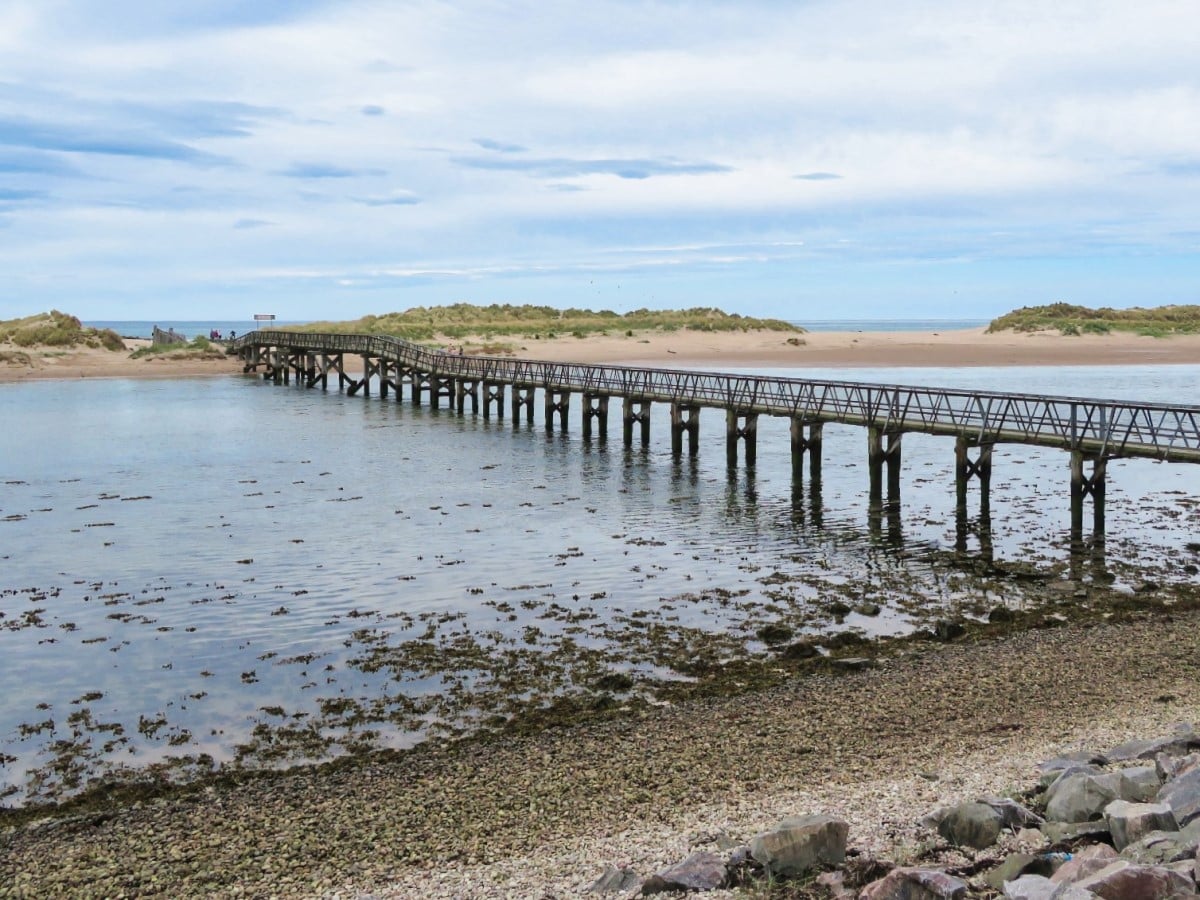
Out About Scotland Guide: Lossiemouth East Beach
Virtual Tour: Lossiemouth East Beach
Lossiemouth East Beach is one of the longest beaches in Scotland, stretching for 7.4 miles from the village of Lossieouth to the mouth of the River Spey. This stunning beach in Moray is a popular destination for both locals and tourists who go there to enjoy sunbathing, swimming, and water sports – especially windsurfing thanks to the stiff breezes that blow in from the North Sea.
The beach is backed by a series of dunes that provide a natural barrier against the winds along with lots of secluded sunbathing spots, while a large pine forest immediately behind the beach offers several walking and cycling trails. As a place for wildlife watching, Lossiemouth East Beach takes some beating, as not only is it a prime birdwatching site, but it’s also one of the best places in Scotland to see pods of bottlenose dolphins.
Lossiemouth village itself has several cafes and ice cream parlours that overlook the beach and it’s also home to an attractive harbour and the Lossiemouth Fisheries and Community Museum which showcases the history of the local fishing industry.
Another nearby attraction is the Covesea Lighthouse, an iconic landmark situated west of Lossiemouth that was built in the 19th century and has since been converted into a museum with guided tours that provide an insight into the history of the lighthouse and the nearby RAF base.
For those interested in outdoor activities, the Moray Coastal Trail is a fantastic option. This scenic trail stretches for approximately 50 miles along the coastline from Findhorn to Cullen and offers lots of opportunities to explore Moray’s picturesque fishing villages, forests, and beaches.
4: Silver Sands of Morar
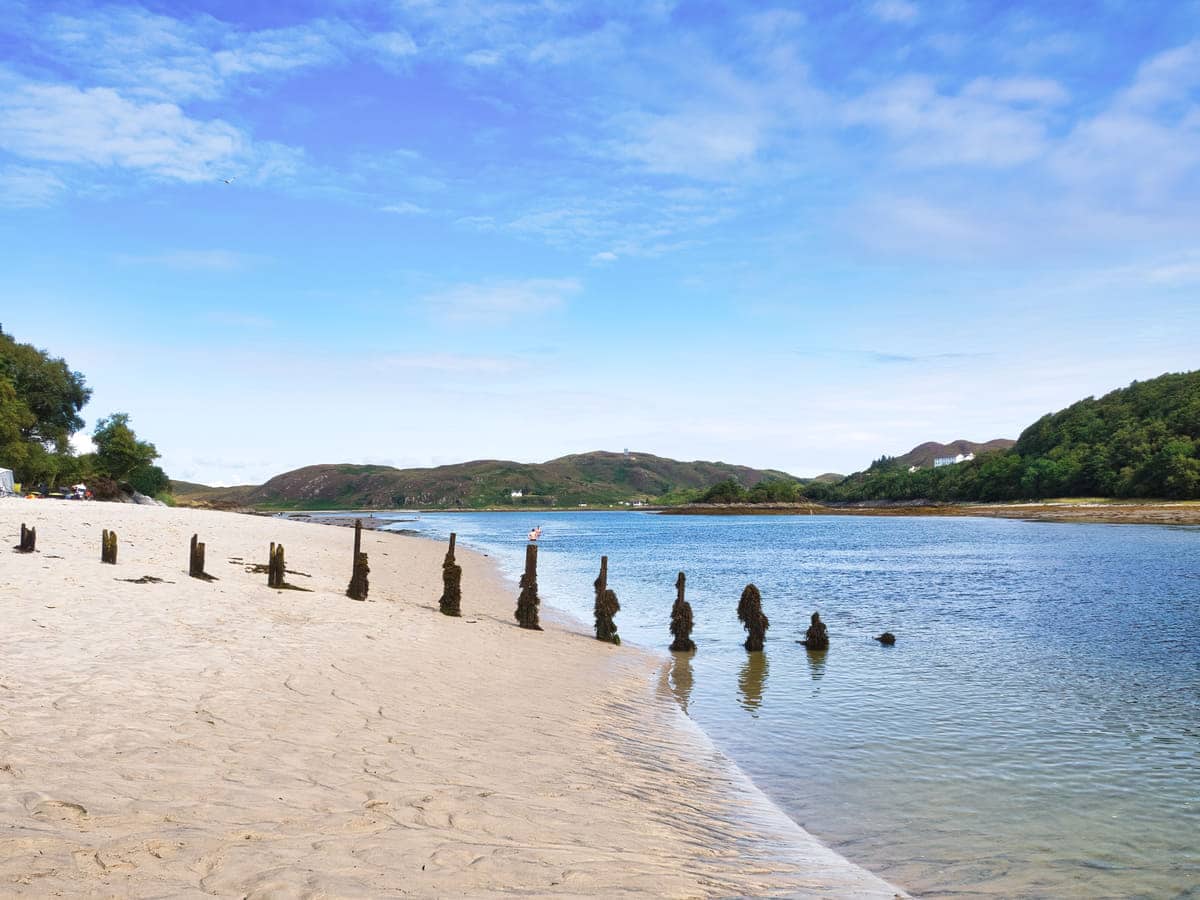
| Address: | Morar Beach car park, B8008, Mallaig, PH40, UK |
| Opening Hours: | 24/7 |
| Admission Price: | Free |
| Parking: | Free on-site car park. Parking spaces on the roadside. |
| Contact: | N/A |
| Facilities: | Toilets in the car park. |
| Photos: | Virtual Tour YouTube Video |
Out About Scotland Guide: Silver Sands of Morar
The Silver Sands of Morar is a stunning beach on the west coast of Scotland, close to the village of Morar and the beautiful Loch Morar.
The ‘Silver Sands’ takes its name from the white sands that border the outflow of the freshwater River Morar (Scotland’s shortest river) and the saltwater Morar Bay. The sand is made up of crushed seashells which gives it a unique silver sheen when sunlight reflects off the surface, while also giving the water an attractive light blue colour.
Morar Bay is relatively shallow, and this protected inland beach – which stretches for a little over a mile along the bay’s southern side – is one of the safest places to go sea swimming in all of Scotland.
Access to the sand is good thanks to the B8008 which runs close to the edge of the beach to a car park (postcode PH40 4PD), but if there are no spaces there’s a chance you’ll be able to find a spot somewhere on the side of the road between the car park and the junction of the A830/B8008.
The area surrounding the Silver Sands of Morar offers a range of attractions for visitors to explore, such as the village of Morar (the Morar Hotel is highly recommended for food and drinks) and Mallaig, which is a historic fishing port and the final destination of the famous Jacobite steam train.
Nature lovers, meanwhile, will enjoy a visit to the nearby Loch Morar, the deepest freshwater loch in Britain. With its stunning views and many lochside paths, it’s the perfect location for a peaceful walk while wildlife spotting, and there’s every chance you’ll see otters, red deer, and even golden eagles as you follow the water’s edge.
For hiking enthusiasts, the coastline south of the Silver Sands offers numerous trails around Camusdarach Beach which, in addition to presenting jaw-dropping views of the isles of Eigg and Rum, is famous for being the filming location of movies including Local Hero, Highlander, and Dragonheart.
5: Traigh a Bhaigh – Isle of Vatersay
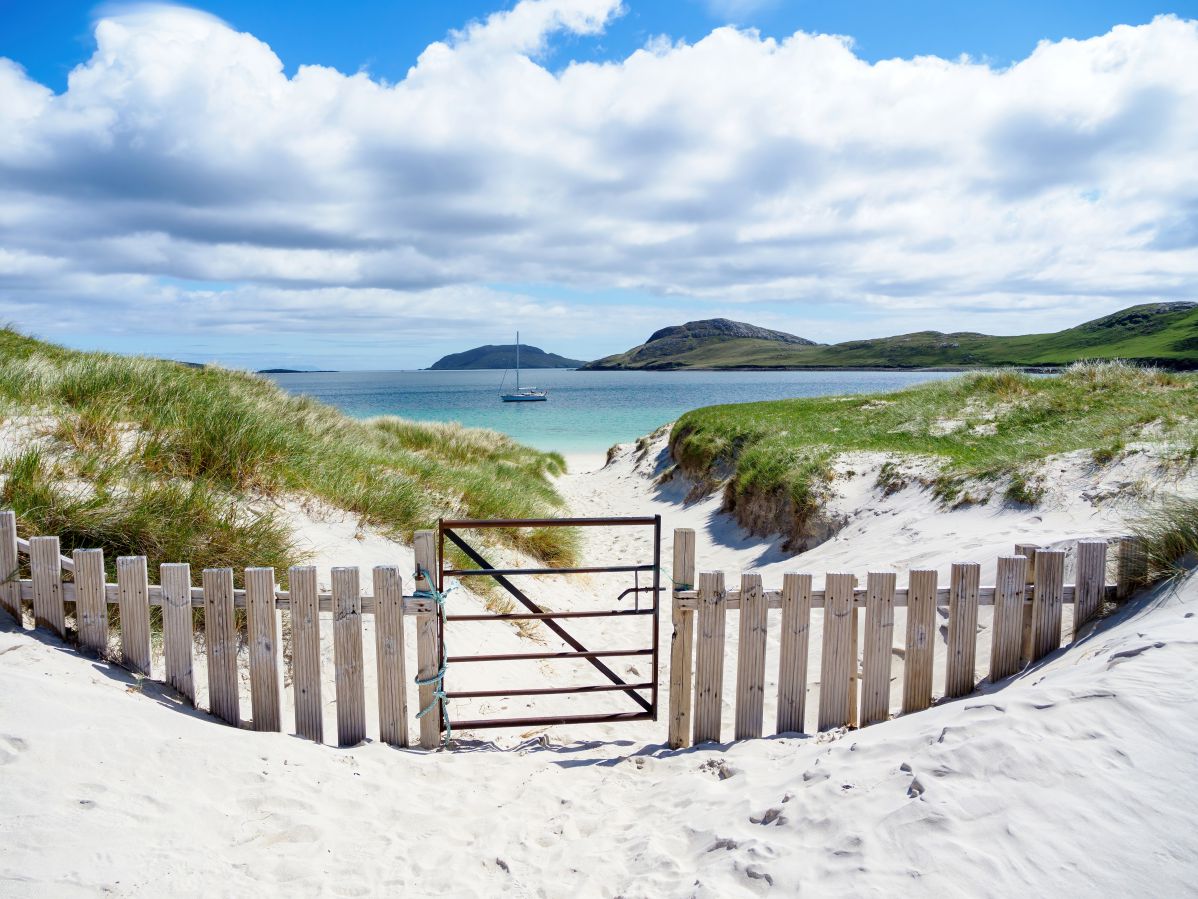
| Address: | Vatersay, HS9 5YW |
| Opening Hours: | The Isle of Vatersay is accessible 24/7, 365 days a year. |
| Admission Price: | The Isle of Vatersay is free to visit. |
| Parking: | There is a car park at the Vatersay cafe and off-road parking between Traigh Shiar and Traigh a Bhaigh beaches. |
| Contact: | N/A |
| Facilities: | Vatersay has a community hall with toilets and showers. The hall has a cafe that serves hot food and drinks with indoor and outdoor seating. The nearest shops are in Castlebay on Barra which has a Co-op (2 miles, address: Na h-Eileanan, Castlebay, Isle of Barra, HS9 5XD) and independent stores. |
| Photos: | Virtual Tour |
Out About Scotland Guide: Isle of Vatersay
Traigh a Bhaigh, also known as Vatersay Bay, is a beautiful and unspoiled sandy beach on the Isle of Vatersay. Vatersay is the southernmost inhabited island in the Outer Hebrides and is connected to the neighbouring Isle of Barra by a 200-metre causeway, around 2 miles from Barra’s largest settlement, Castlebay.
Traigh a Bhaigh beach is a very popular place for swimming and sunbathing as it’s bordered on its western side by another beach – Traigh Shiar – which can be accessed via a short walk across a flat plain of machair (a type of flowering grassland).
The ability to swap between east and west beaches means you can easily escape from the wind no matter its direction, or head to whichever beach has the best waves if windsurfing is the activity of choice.
Near the northern end of the beach, you’ll find the Vatersay Community Hall, which has a cafe with outdoor seating that serves locally sourced food. The cafe is a must-visit as the home-cooked food is delicious, so it’s a great place to fill hungry bellies before setting off on a tour of the Hebridean Way, the 184-mile walking and cycling route that stretches across the Outer Hebrides from Vatersay to Lewis.
If you’re looking for more beaches to explore you can visit Bagh A’Deas (often considered the true starting point of the Hebridean Way) or head over to the Uidh promontory on Vatersay where you’ll find more secluded beaches.
Other things to do near Traigh a Bhaigh beach include visiting Kisimul Castle, kayaking around Caolas Bhatarsaigh (the channel between Vatersay and Barra), and visiting the Barra Heritage & Cultural Centre in Castlebay which features galleries of local historic artefacts.
Explore the islands of Scotland’s Outer Hebrides on a Rabbie’s small-group tour
6: Gott Bay – Isle of Tiree
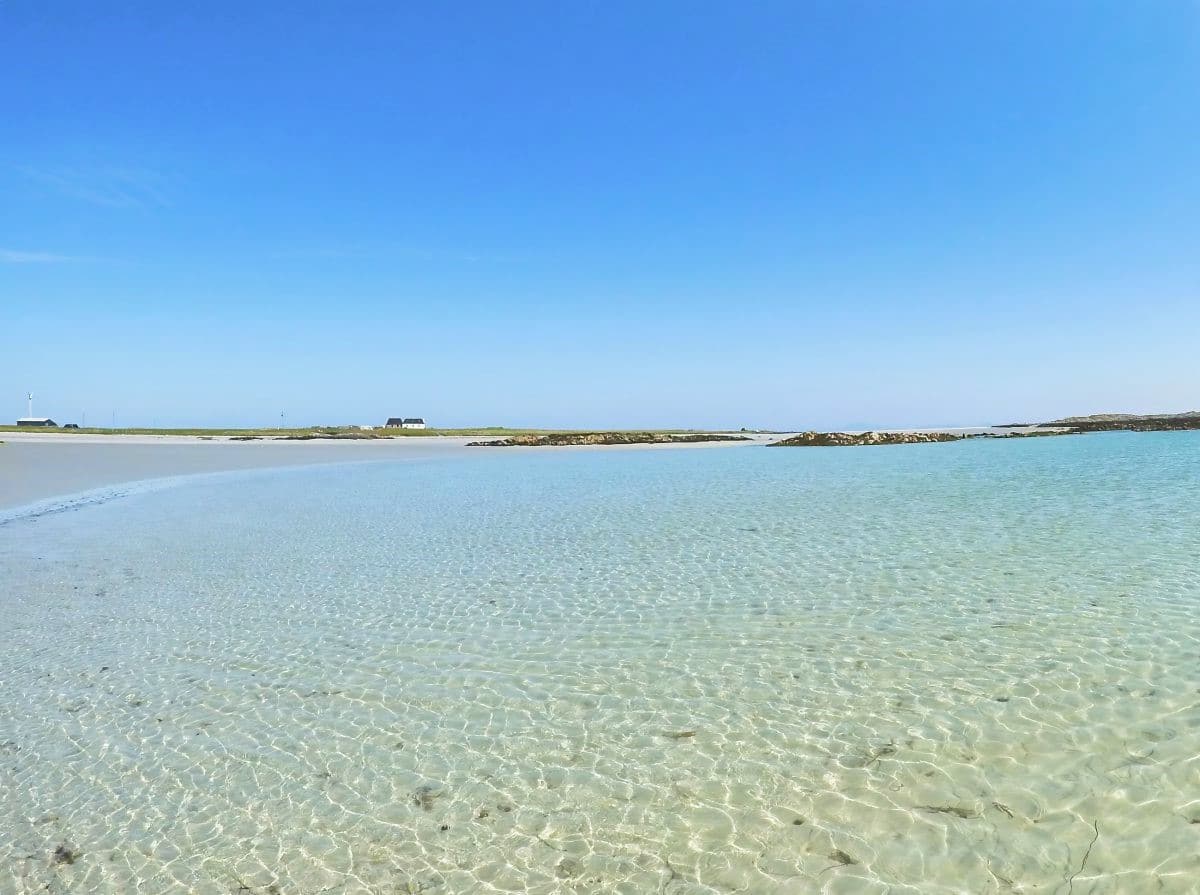
| Address: | Kirkapol, Isle of Tiree, PA77 6TW |
| Opening Hours: | Gott Bay is accessible 24/7, 365 days a year. |
| Admission Price: | There is no fee to visit Gott Bay. |
| Parking: | There is a free off road parking area on the northen end of Gott Bay just before the settlement of Ruaig (postcode PA77 6TR). There are a couple of smaller off road parking areas along the edge of Gott Bay which are marked with blue signs. |
| Contact: | NA |
| Facilities: | Car park. The Tiree Lodge Hotel has a restaurant, bar and toilets. |
| Photos: | Virtual Tour |
Out About Scotland Guide: Gott Bay
Gott Bay is situated on the eastern side of the Isle of Tiree (AKA ‘the Hawaii of the North’) in Scotland’s Inner Hebrides. Known for its long, crescent-shaped beach, it’s almost two and a half miles long and is one of the top destinations in Scotland for beach holidays.
If arriving by ferry, Gott Bay is the first beach you’ll come across if you turn right off Pier Road near the terminal. There are a couple of parking spaces on the grass behind the dunes near the Tiree Lodge Hotel which is a great spot to sit and enjoy the view, but there are no shops in the area so you’ll have to double back to the Co-op in Scarinish if you fancy a picnic.
Visiting Gott Bay is a must-do experience for any tourist as it offers superb walks with stunning views of the Atlantic Ocean and it’s also an ideal spot for water sports – particularly for windsurfing and kitesurfing as the bay is known for its consistent winds.
One big bonus of visiting Tiree for its watersports is the fact that Gott Bay is a short drive from the bays of Vaul and Salum which are less than a mile away on the opposite side of the island, meaning it’s easy to pack up and move somewhere windier if the need arises.
The beach of Gott Bay is broken in the middle by a few rock outcrops but otherwise, the sand is pristine, and coupled with its shallow turquoise waters this Scottish beach looks more like the Caribbean than an island off the northwest coast of Britain.
The wildlife around Gott Bay is also a major draw for tourists, as it’s home to a diverse range of bird species, including oystercatchers, terns, various gulls, and the elusive corncrake, and there’s a good chance of spotting seals basking on the rocks or swimming in the waters of the bay.
With regard to other attractions on Tiree, I recommend Skerryvore Lighthouse Museum at Hynish (postcode PA77 6UG) which is dedicated to Scotland’s tallest lighthouse, or Caolas Beach on the northern tip of the island which has fabulous views of the islands of Gunna and Coll.
7: Traigh Mhor – Isle of Barra
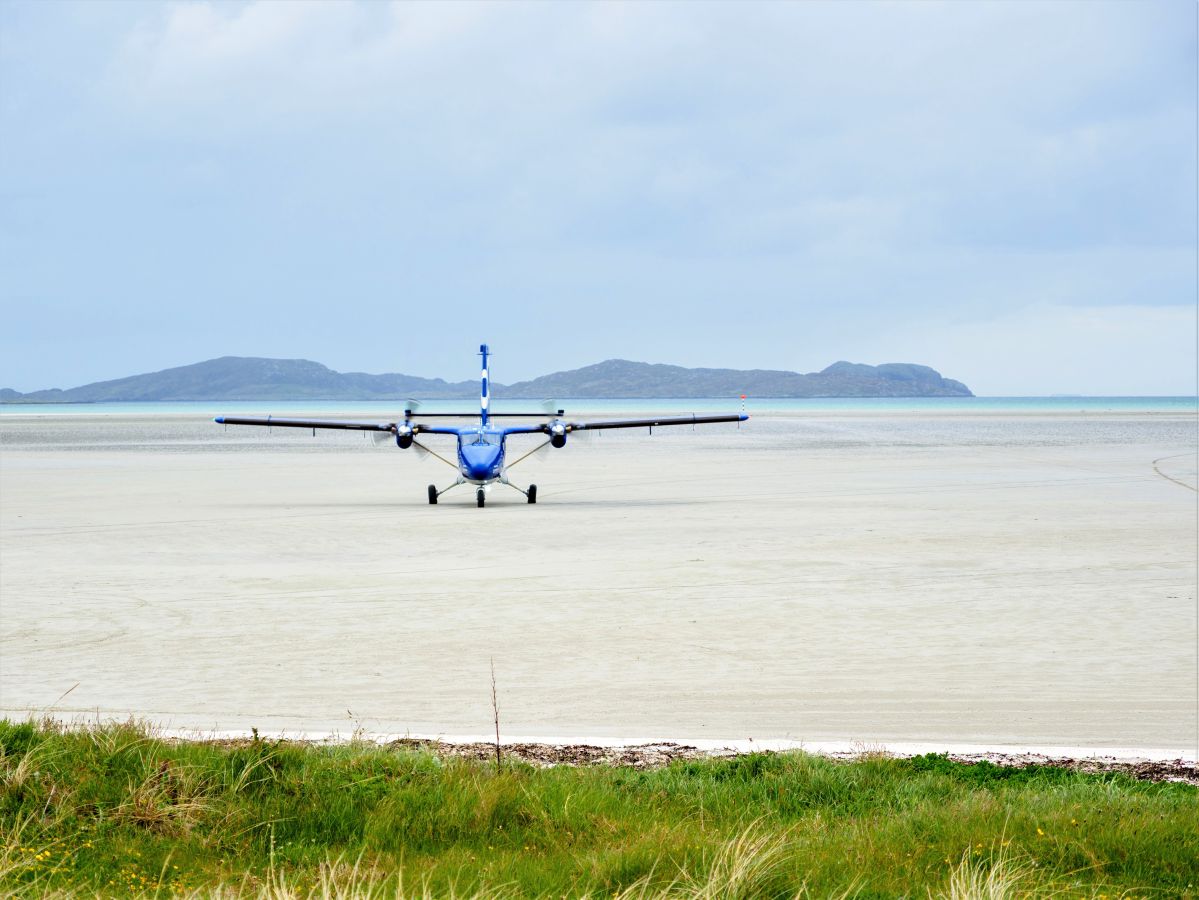
| Address: | Isle of Barra, HS9 5YR |
| Opening Hours: | All beaches on the Isle of Barra are accessible 24/7. |
| Admission Price: | There is no fee to visit any of the beaches on the Isle of Barra. |
| Parking: | Barra Airport (Address: Eoligarry, Isle of Barra, HS9 5YD) has a dedicated car park for airport users. Next to this car park is a secondary parking area for beach visitors. Traigh Mhor car park is free to use. The surface is compacted gravel. Additional car parking areas suitable for motorhomes can be found on the side of the road on the southwest edge of Traigh Mhor beach. |
| Contact: | N/A |
| Facilities: | There are no facilities on Traigh Mhor beach other than car parking areas. Barra Airport has public toilets, a cafe, and vending machines for drinks and light snacks. |
| Photos: | Virtual Tour |
Out About Scotland Guide: Traigh Mhor, Barra
Traigh Mhor Beach – also known as Cockle Strand – is famous for being the only beach in the world where scheduled flights land during low tide. Though the beach is officially part of Barra Airport, visitors are allowed to explore it at times when there are no inbound flights.
Visiting Traigh Mhor is a one-of-a-kind experience. You can watch planes landing and taking off from the beach and at the same time you can relax on white sands that run for over a mile along the edge of the horseshoe-shaped bay which offers lovely views across the sea to the islets of Orosay and Hellisay.
The beach is easy to get to thanks to a single-track road that runs alongside it and there are lots of parking spaces where you can sit and soak up the views, but for those visitors heading to Traigh Mhor to watch the planes come in, it’s best to park in the purpose-built car park next to the airport (postcode HS9 5YD).
Traigh Mhor is positioned on the eastern side of the Eoligarry peninsula which has an even bigger beach on its western side (Traigh Eais beach), which is just a 5-minute walk across a wildflower-covered meadow. This beach is a wee bit nicer than Traigh Mhor, in my opinion, so if you’re looking for a family beach day, I recommend leaving the car near the airport, watching the planes land, and then walking over to Traigh Eais.
The beach is around one mile in length and 200 feet in width so you’re pretty much guaranteed to find somewhere secluded where you can sunbathe in peace and quiet – apart from the planes flying overhead, of course.
There’s lots of wildlife to watch around Traigh Mhor and seals are often spotted lounging on the shoreline while otters and dolphins are frequently seen in the sea. Birdwatchers can enjoy the sight of various seabirds such as oystercatchers, sandpipers, and terns, while a little further south there’s a good chance of seeing golden eagles soaring overhead.
As for other attractions, the Barra Heritage & Cultural Centre (postcode HS9 5XD) explores the island’s history and culture, while Castlebay is the departure point for boat trips to explore the nearby islands of Sandray, Pabbay, and Mingulay.
8: Yellowcraig – East Lothian
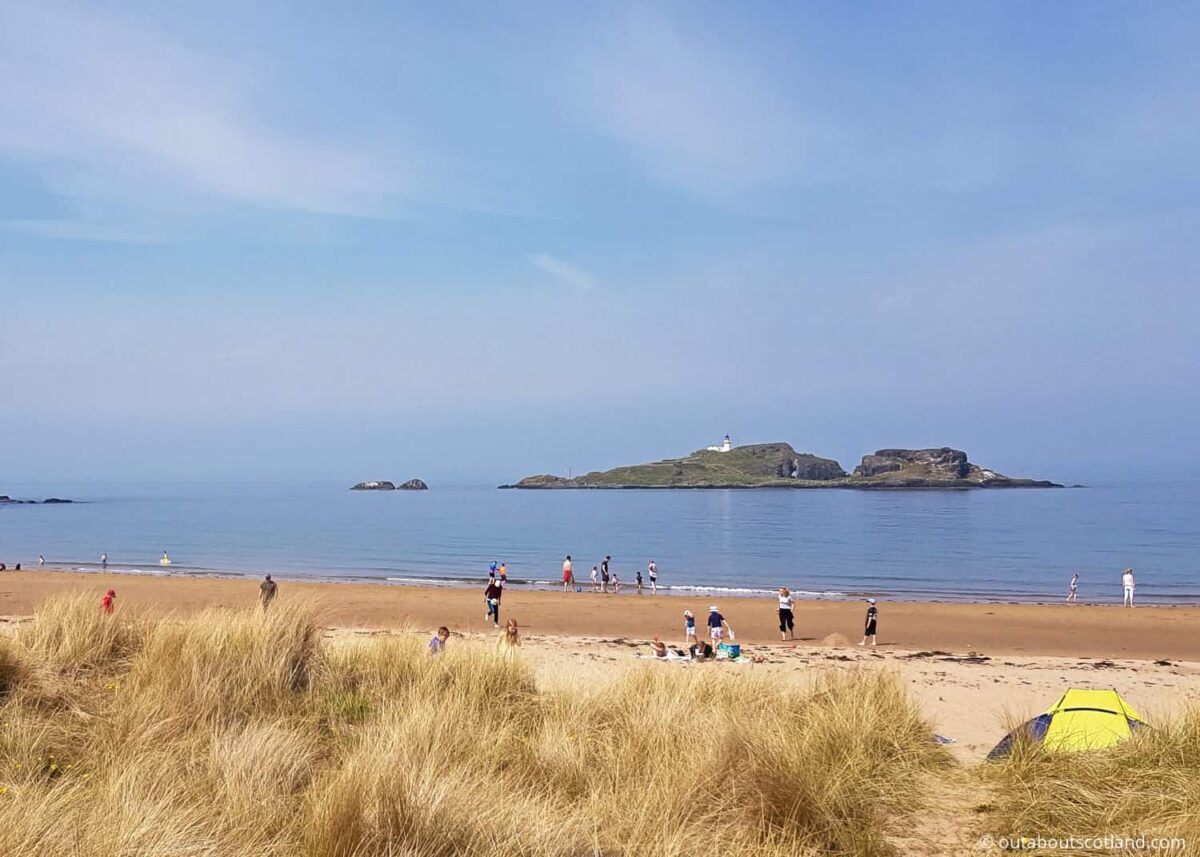
| Address: | North Berwick, EH55 |
| Opening Hours: | 24/7 |
| Admission Price: | Free |
| Parking: | Paid car park on-site. Charging period: 1st April - 30 Sept: 8.00 am - 6.30 pm 1st Oct - 31st March: 8.00 am - 4.00 pm |
| Contact: | N/A |
| Facilities: | Toilets, temporary snack van, picnic area, play park |
Out About Scotland Guide: Yellowcraig Beach
Yellowcraig Beach is located on the northern coastline of East Lothian, the county immediately to the east of Edinburgh. Although known as ‘Scotland’s larder’ due to its rolling farmland, East Lothian is a fantastic destination for anyone looking for a beach holiday as it’s home to a near-uninterrupted 40-mile stretch of sheltered coves and bays.
Yellowcraig Beach is accessed from the quaint village of Dirleton just off the A198 and can be driven from the outskirts of Edinburgh in less than half an hour, making it a great place to take a break from the hubbub of the capital city.
While all of the beaches in the county are worth a visit, Yellowcraig is the most family-friendly of them all. It’s dog-friendly so you can take your furry friend along with you for a fun-filled day and there’s a playground near the car park so the kids can burn off energy if they get bored of sitting on the beach.
The sand at Yellowcraig is soft and golden so it’s a fantastic place for sunbathing, and anyone looking for a more adventurous day can follow the coastline around to West Bay Beach in North Berwick.
Facilities at Yellowcraig are pretty good thanks to a large car park situated a short walk from the beach where there are public toilets and showers as well as a wheelchair-accessible path and a ramp with great views over the Firth of Forth.
One of the main attractions of Yellowcraig is Fidra Island, a small and uninhabited nature reserve 1/3 mile offshore that’s home to a lighthouse and a wide range of birds including puffins and gulls. The island is said to have inspired Robert Louis Stevenson’s novel Treasure Island and is a good place to paddle around for anyone visiting with a kayak.
In addition to the natural beauty of the beach and its surroundings, the nearby town of North Berwick offers a range of shops, cafes, and restaurants as well as attractions such as the Scottish Seabird Centre, while a little further down the coast you’ll find one of Scotland’s oldest fortresses at Tantallon Castle.
9: Balnakeil – Sutherland
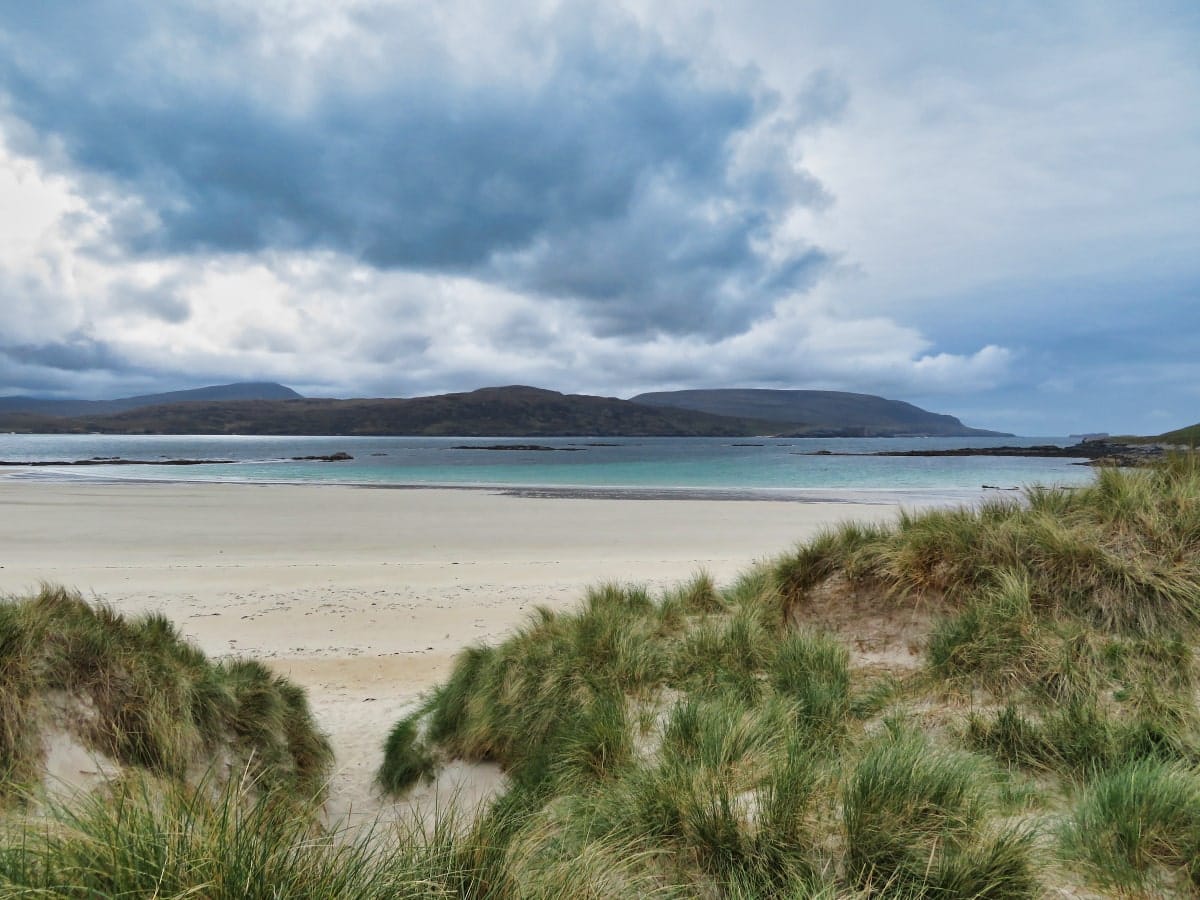
Out About Scotland Guide: Faraid Head
Virtual Tour: Faraid Head
Balnakeil Beach is a beautiful, sweeping arc of golden sand in the furthest northwest corner of Scotland. One of the most challenging beaches on this list to access, but the breathtaking scene of rolling dunes and crystal-clear waters is worth the effort. The beach is 1.3 miles in length and is surprisingly wide at around 600 feet, and coupled with the fact that it sees relatively few visitors, it feels incredibly remote.
Faraid Head, the headland that Balnakeil Beach merges into, is a Site of Special Scientific Interest and is one of the best places in Scotland for birdwatching as it’s a haven for seabirds including puffins, guillemots, and razorbills, while Balnakeil Bay is a great place for spotting whales and dolphins.
The beach is accessed by a single-track road from the village of Balnakeil which ends at a small car park near the village’s graveyard. To the immediate west is Durness Golf Club and to the immediate north is the beach which is fenced off but can be accessed through a wooden gate.
There’s a further road that runs right through Faraid Head to its northernmost tip, where an old military outpost sits overlooking the cliffs, but while this road can be walked along, it’s not permissible to take any vehicles on it, including motorhomes and cars.
In terms of nearby attractions, there’s Balnakeil Craft Village, a community of artists and craftspeople who’ve set up shops in a former military base, and Smoo Cave which is a fascinating geological wonder 2-miles to the east.
This enormous limestone cave complex features a beautiful underground waterfall which is a must-see for anyone visiting the area. Guided tours are offered throughout the tourist season which are highly recommended as you get to explore the innermost reaches of the cave.
Another recommended attraction is the already-mentioned Durness Golf Club which offers a challenging nine-hole course with stunning views of the surrounding coastline. The course is a great opportunity to enjoy a round of golf while taking in the scenery of Balnakeil – but golfers need to brace themselves for the unrelenting winds that blow across the bay from the North Sea.
10: Loch Morlich – Cairngorms
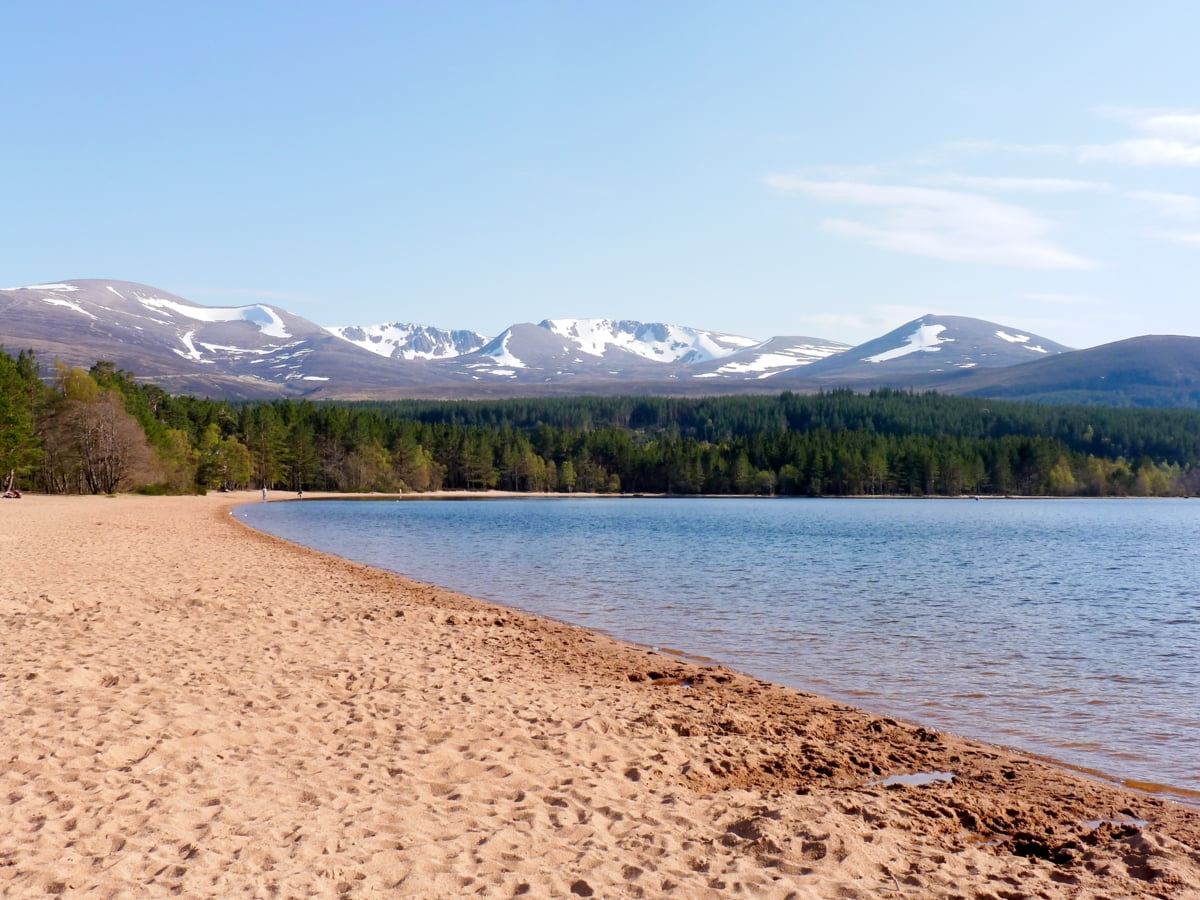
| Address: | Aviemore, PH22 1QU |
| Opening Hours: | 24/7 |
| Admission Price: | Free |
| Parking: | Paid car park on-site: £2 for up to 1 hour £3 for up to 3 hours £4 for all-day (vehicles up to 7 seats) £12 for minibus or coach all-day Blue Badge holders park for free |
| Contact: | Watersports centre: 01479 861 221 info@lochmorlich.com |
| Facilities: | Cafe, toilets, partial disabled access, picnic area, watersports hire |
Out About Scotland Guide: Loch Morlich
This is one of Scotland’s few inland beaches, and it’s also a personal favourite of mine. Loch Morlich is a freshwater loch in the heart of the Cairngorms National Park. It sits at an altitude of 300 metres (980 feet) above sea level, making it the highest beach in the UK, and spans an area covering half a square mile (around 120 hectares).
The entire body of water is surrounded by the vast Glenmore Caledonian pine forest which is itself framed by the backdrop of the Cairngorm mountain range, and as you can probably imagine, the views are stunning in every direction.
At the eastern end of the loch, near the forest entrance, you’ll find the lovely Loch Morlich Beach which is a strip of golden sand roughly 1/3 mile in length. Visiting Loch Morlich Beach is a superb experience for families, couples, and solo travellers alike as it offers a wide range of outdoor activities for all ages and interests.
You can enjoy exciting watersports like canoeing, windsurfing, and sailing on the loch, or just take a leisurely walk or cycle around the shoreline on well-maintained paths. A watersports centre on the northern end of the beach has an equipment rental shop and a cafe, and there’s a large campsite nearby if you’d like to spend a few nights in the area.
The Glenmore Forest Park Visitor Centre is located nearby where you can learn about the local wildlife and the history of the park, and a wee bit further up the road you’ll find the Cairngorm Reindeer Centre where you can interact with the only free-ranging reindeer herd in the UK.
A visit to the Rothiemurchus Estate (5 miles to the west) is also highly recommended. The estate offers a range of guided walks, wildlife watching, and outdoor activities like fishing and clay pigeon shooting, while the town of Aviemore (another 2 miles west) offers a variety of shops, pubs, and restaurants.
11: Ayr – Ayrshire
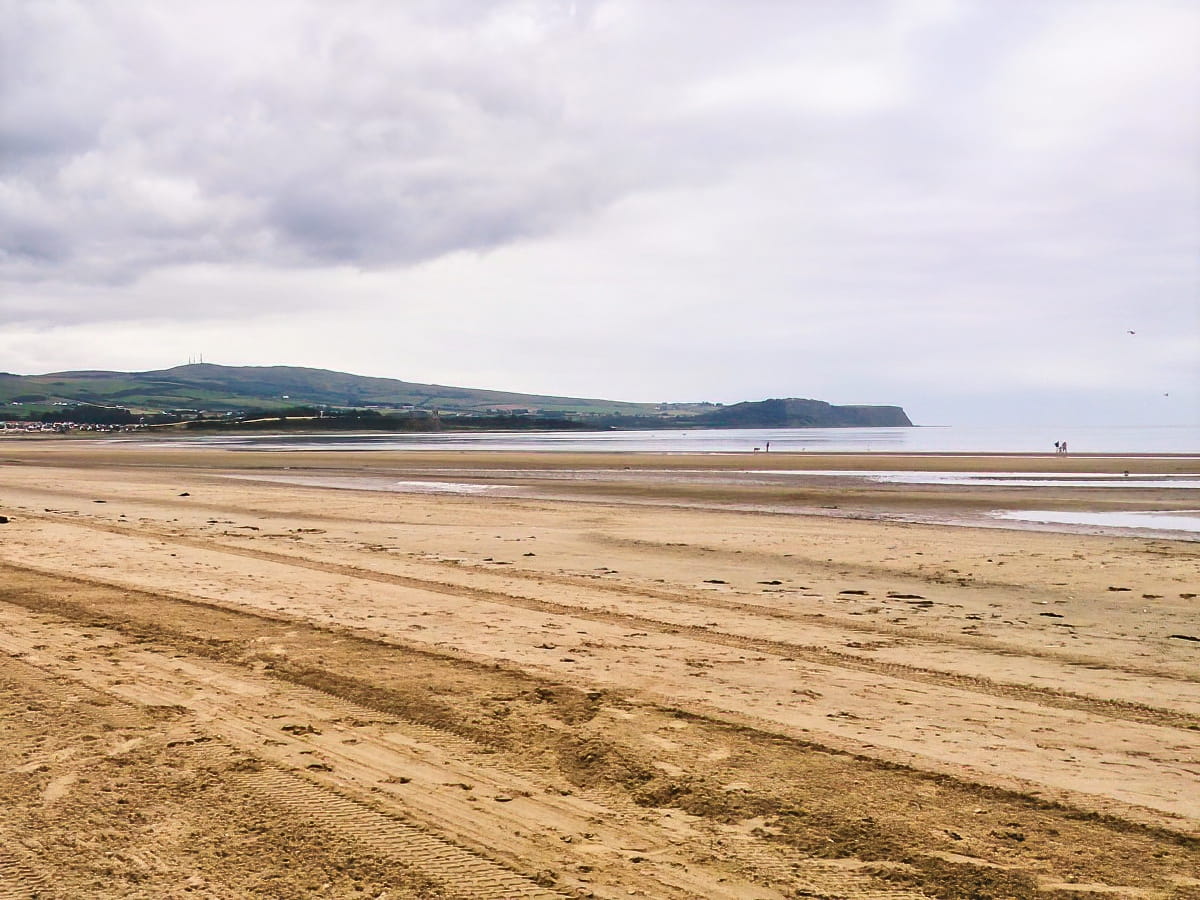
Ayr Beach stretches along the shores of the Firth of Clyde in the county of Ayrshire where it offers easy access to several other beaches between Bracken Bay 5 miles to the south and Ardrossan 20 miles to the north.
All of the beaches along this southwest region of the country are worth a visit, but Ayr Beach with its golden sands and relaxed seaside atmosphere is, in my opinion, one of the best beaches on Scotland’s mainland. Not only is it an ideal destination for tourists exploring Scotland, but it’s also perfect for day-trippers from Glasgow which is less than an hour’s drive away.
In addition to its beautiful setting which overlooks the Isle of Arran, Ayr Beach is known for being one of the cleanest beaches in Scotland which is why it has received a Seaside Award – the only national award that celebrates clean, well-managed beaches – for its high standards.
As it’s part of the National Cycle Route #7, the promenade along the beach is perfect for leisurely strolls or cycling and there are plenty of grassy areas for picnics at the southern end while the northern end is close to lots of visitor facilities including toilets, car parks, restaurants, and shops.
Ayr Beach is also close to several family-friendly attractions such as Pirate Pete’s Family Entertainment Centre which features an indoor play area, a mini-golf course, and an amusement arcade, and the Citadel Leisure Centre which has a 25-metre, 6-lane swimming pool.
The town of Ayr itself is steeped in history and is well worth exploring. It’s the birthplace of the Scottish poet Robert Burns whose cottage can be visited in the nearby village of Alloway, and Ayr’s town centre offers a range of shopping and dining options as well as a bustling nightlife.
Furthermore, Ayr is a great base for exploring the surrounding area including the town of Troon with its many golf courses and the stunning Galloway Forest Park which is one of the few designated dark sky areas (places with no light pollution) in the UK.
12: Aberdeen – Aberdeenshire
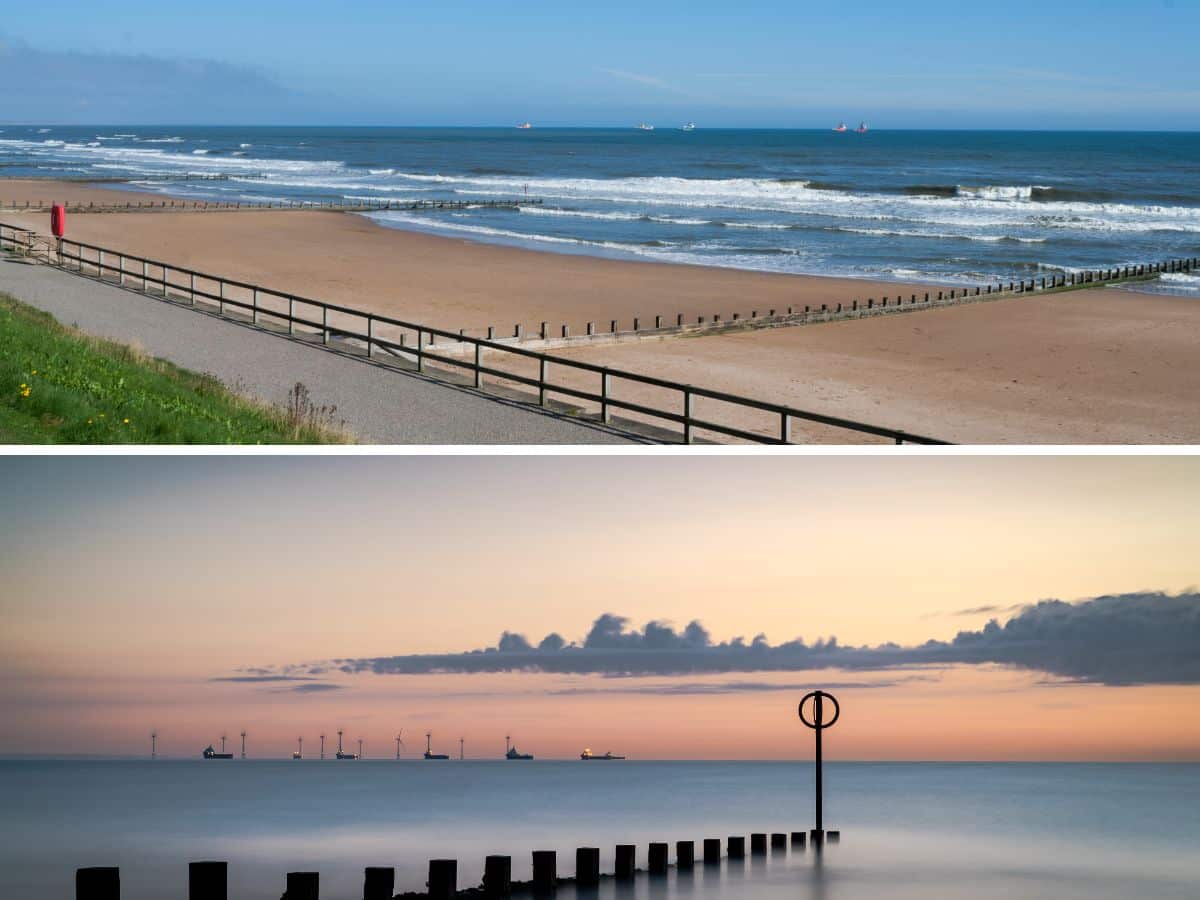
Aberdeen is a lively city on the northeast coast that attracts thousands of tourists each year, partly because of its own attractions and partly because it makes a great base to explore both Speyside (one of Scotland’s biggest whisky-producing regions) and the Cairngorms National Park.
While it’s best known as the main hub of the North Sea oil and gas industry, Aberdeen is a superb place to head to for a beach holiday thanks to the vast stretch of golden sand that starts near Aberdeen Harbour and continues north for 11 miles to the village of Newburgh (though it’s broken by the mouth of the River Don 2 miles north of the harbour).
This entire beach boasts soft golden sand which makes it a perfect spot for sunbathing, and thanks to the fact that it’s only a mile from the city centre it’s easy to get to whether travelling on foot, by bus, or by car.
Aberdeen Beach is well known for its cleanliness and good water quality so it’s suitable for swimming during the warmer months when the water temperature averages 13°C, and it’s also a popular destination for surfers due to its consistent waves. Perhaps the best reason to visit the beach for families is the number of nearby attractions which ensures there’s something for all ages to enjoy.
The Esplanade, a pedestrian-friendly area, is perfect for a leisurely stroll while Codona’s Amusement Park offers a range of fun old-school rides and games. There’s also an ice rink, a traditional ballroom, several play parks, lots of fast food restaurants, shops, and plenty of parking spaces, meaning Aberdeen Beach is unmatched when it comes to visitor facilities.
History enthusiasts can visit the historic Footdee (Fittie) village, a charming fishing community with an array of well-preserved 19th-century cottages, and the city of Aberdeen itself is steeped in history as it’s one of the oldest cities in Scotland.
Known as the ‘Granite City’ due to its grey stone buildings, Aberdeen is home to a wealth of notable landmarks including the medieval University of Aberdeen and the beautiful St. Machar’s Cathedral. The city also boasts a thriving arts scene with numerous galleries, theatres, and live music venues
Frequently Asked Questions
What is the nicest beach in Scotland?
The nicest beach in Scotland is subjective as different people may have different preferences. However, Luskentyre Beach on the Isle of Harris is often considered one of the most beautiful beaches in Scotland as it features stunning white sands and turquoise waters and is surrounded by picturesque hills and dunes.
Does Scotland have any beaches?
Yes, Scotland has many beautiful beaches. Some popular ones include Luskentyre Beach on the Isle of Harris, Balmedie Beach in Aberdeenshire, St Andrews West Sands in Fife, and Balnakeil Beach in Sutherland.
Each of these beaches offers stunning landscapes, clear waters, and lots of opportunities for outdoor activities whether sunbathing, swimming, or enjoying water sports.
Can you swim at beaches in Scotland?
You can swim at all beaches in Scotland as long as there are no warnings in place due to strong currents or any other hazards. However, the water temperature can be quite cold, especially outside of the summer months. It’s always a good idea to check the local weather and water conditions before going for a swim, and consider wearing a wetsuit for added warmth and protection.
Some popular beaches for swimming in Scotland include Sango Sands in the Highlands, Gullane Bents in East Lothian, and Coldingham in the Scottish Borders.
Is there a beach in Glasgow?
There isn’t a beach in Glasgow as it’s an inland city. However, you can find beaches near Glasgow by travelling a bit further.
One popular option is Ayr Beach which is about 37 miles southwest of Glasgow and can be reached in approximately an hour by car or train. Another option is Troon Beach, also around an hour’s drive from Glasgow.
The nearest coastal beach to Glasgow is Lunderston Bay at 31 miles. Alternatively, there’s an inland beach at Balloch Country Park near Loch Lomond which is located 27 miles northwest of Glasgow.

